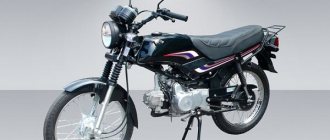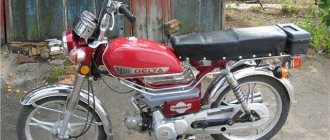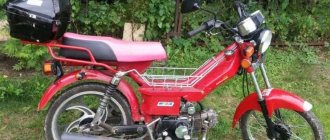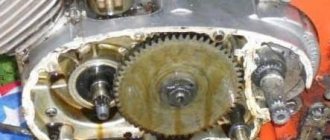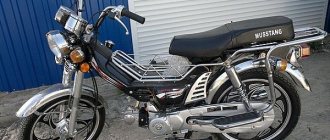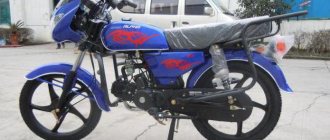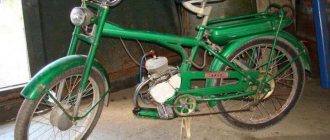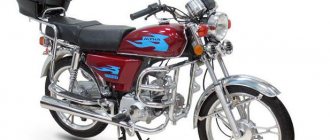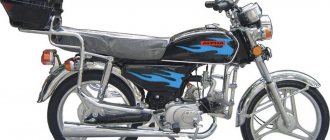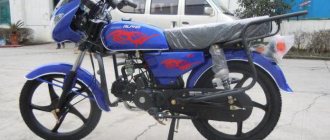In the post-Soviet space, the Karpaty moped is one of the most popular small vehicles on two wheels. Compared to similar units, the device in question was distinguished by good quality, practicality and original design. Among the features, it is necessary to note the three-block type clutch. The two-speed gearbox provided a fairly good smooth start and maximum speed (45-50 km/h).
Peculiarities
Despite the fact that it was almost impossible to somehow tune the unit, its ease of maintenance and the ability to independently repair absolutely all units certainly played a key role in its popularity. Original spare parts for the Karpaty moped were made of high-quality metal, although the equipment of that time often broke down due to design and technical flaws.
The trunk of the vehicle in question could withstand more than one hundredweight of cargo. The tires had a high tread, which made it possible to operate the equipment in winter. Drum brakes were quite enough for the weight and dynamics of the small motorcycle. The power unit itself is a regular two-stroke engine. Almost every owner of this representative of motorcycle equipment can replace the rings or piston.
Greetings from the 90s: new moped “Karpaty-2”
Just recently I told you about the new moped “Verkhovyna-3”
1971, discovered in Latvia in the attic of a private house.
And so, just the other day, a subscriber wrote to me on Facebook
and said that at his dacha, in his garage, there was also a completely new moped produced by the Lvov Motorcycle Plant.
A classic garage find: a piece of a moped is visible behind a pile of junk
True, we were talking about a later model - “Karpaty-2”, approximately from the early 90s. The moped (or correctly - mokik) was located in a small village not far from Kyiv, so we decided not to hesitate and after a few days we set out to view the rarity. Moreover, we were lucky with the weather - a warm autumn day, Indian summer outside.
In the process of freeing equipment from the rubble of junk
Upon arrival, it turned out that the device was littered with a bunch of rubbish and various household utensils - it was almost invisible. I had to spend about 20 minutes sorting through these deposits of garage junk - it was a good warm-up. But when we finally got to the bottom of the coveted technology, joy knew no bounds - completely new “Karpaty” pink-brick colors appeared in front of us.
The area has been cleared - now you can examine the device in detail
Having rolled out the 2-wheeled dream of schoolchildren of the 80s and 90s onto the street, we began a detailed inspection. So, before us is the Karpaty-2 mokik (factory name LMZ-2.161), judging by the plate on the frame, manufactured in 1993, in completely new condition.
Late Carpathians-2 of unusual color
Seat upholstery in young leatherette leather - the work of the first owner
Factory tin plate with model name. Year of release: 1993
According to the seller, the moped belongs to his wife’s father, who purchased it in the early 90s at one of the national economic exhibitions that took place in the capital. After purchasing it, he drove it around the village only a few times, and then stored it in the garage, where it has been for the last 23 years.
In the entire Union, guys, there is no cooler moped than the Carpathians
The dream of schoolchildren of the 80-90s. There is no speedometer on this modification, so it is impossible to find out the exact mileage, but the condition shows that it is no more than 100 km
“Karpaty-2” is the last production model of the Lviv Motor Plant: produced from 1986 to 1997. In better times, the company collected about 300 thousand mokiks annually, but in the second half of the 80s, demand began to fall, and production dropped to about 120-130 thousand pieces per year.
Since 1989, the fenders began to be painted in the color of the frame, and before they were chrome
The Karpaty-2 model was produced until 1997
Despite the fact that this mokik was released after the collapse of the Soviet Union, almost all of its parts (tail light, headlight, spark plug) bear the “Made in the USSR” markings: apparently, the plant still had a decent supply of components.
Competitors
The unit received the closest competitor in terms of characteristics in the “face” of the Verkhovyna vehicle. The Karpaty moped's ignition, clutch assembly, design and some other indicators were significantly superior to its rival. In addition, “Delta” and “Verkhovyna-7” competed with the vehicle in question. Although all components of these variations were modernized, preference was given to the “Carpathians”.
There are several reasons for this. Firstly, the price of the Delta was higher, and it was produced in Riga. Secondly, the improved Verkhovyna had a guaranteed mileage of 6,000 kilometers, and a service life before major repairs of 15 thousand. The Karpaty moped at the same time had eight and eighteen thousand, respectively.
More than one generation, especially in rural areas, has studied every cog in this unit. A brief overview of the location of the main elements:
- The air filter is located directly behind the carburetor.
- The gearshift control lever is on the left, the brakes on the right.
- Also on the steering wheel is the clutch handle, gas, and front brake.
It is worth noting that there is no electric starter, so a fairly popular way to start the engine was to activate it with a “push” or “claw”.
Comments 248 – Neutral reviews
Engine left view 1 - noise suppression tip; 2 — rubber-metal bushing; 3 - carburetor; 4 — filler plug; 5 — hole for checking the oil level; b — gear shift lever only for the V501 engine; 7 — drain plug; 8 - seal. But it’s not enough to say that we are retreating at an acute angle because the French are moving between both armies, this angle is becoming even sharper, and we are moving even further because Barclay de Tolly, an unpopular German, is hated by Bagration, who has to become under his command, and Bagration, commanding the 2nd Army, tries not to join Barclay for as long as possible, so as not to become under his command.
Nuances of repair work
Almost every owner could repair the Karpaty moped independently. Quite often it was necessary to rebuild the engine. No matter how difficult this work may seem, thanks to the simple design of the motor of the unit in question, everything could be done quickly and efficiently.
If the cause of the breakdown is the failure of the bearings, crankshaft, rings, the engine will need to be split. This is a relatively simple procedure, much more difficult to put everything back together correctly. Although, if you pay close attention to the process and recommendations in the instructions, everything is very real.
Gaskets for the muffler can be cut out of thick cardboard and lubricated with grease. Important: when tightening the nuts, it is necessary to maintain the optimal force, avoiding insufficient fastening or stripping the threads. The Karpaty moped runs on a mixture of gasoline and oil; there is no special oil receiver. The optimal fuel is AI-80.
Clutch
The weakest component in the engine of this moped is the clutch. And it fails first. Oh, and we suffered with this clutch, not only on “Karpaty”, but also on “Riga” and “Verkhovyna”.
In this clutch, the release lever was screwed in first. In those days we called it “bronze finger”. At that time, this device was in terrible short supply and it was simply impossible to find it.
In the one I tested, the release valve was in working order. As they say, he still has to walk and walk.
For those who don’t know, the release lever is located here. Pay attention to how much chips and dirt there are in this engine.
The second weak point of the clutch is its pressure plate, in which it constantly breaks the locking grooves, causing it to fly off the basket.
Removing the pressure disk is very simple: insert a screwdriver into a special hole, hit it a couple of times with a hammer and the disk comes off.
In this example, the grooves through which the disc engages with the basket are still good. Sometimes they are so broken that the disk simply no longer holds on. In such cases, the disk had to be replaced.
The clutch basket spring does not cause any trouble.
The nut that secures the inner drum of the basket was no longer original. There was no thread on it, just like on the crankshaft journal, and it was simply flattened and hammered onto the shaft. It is worth saying that the thread and this entire assembly as a whole are very flimsy. And because of this, the threads constantly screw up and break the splines. And on all engines of this series without exception.
If your nut turns out to be well tightened (which happens very, very rarely), fix the piston through the outlet window with a screwdriver and unscrew it.
The collective farm grower who slapped the nut under the nut did not solve the situation with its spontaneous unscrewing. This is not surprising - the problem is not in the nut, but in the level of technical literacy of the creators of this engine.
The inner drum splines are badly worn. Rapid wear of the splines of this pair is a typical problem with engines of this series.
On all clutch pressure plates without exception, the fingers with which they engage with each other dangle. I put them on the anvil, riveted them on the reverse side and forgot about this problem for a while.
Clutch discs, unlike other clutch parts, do not cause unnecessary trouble.
Often and thickly, the gear breaks off on the outer drum of the clutch basket. I corrected this situation something like this: I put the torn gear back into the basket, pressed it against the basket with a clamp, poured water into the jar, laid the basket on the jar so that the gear was completely hidden in the water and welded it to the body. Then I polished the welds and got a fully functional basket.
The basket on this example is perfect.
The spacer bushing for the outer drum was no longer original and most likely homemade.
We fix the gearbox input shaft gear from turning, unbend the lock washer and unscrew the nut.
The driven gear never breaks and runs for decades. And for some reason the nut that holds it does not unscrew... How can this be done??? Two almost identical units are located next to each other, made at the same factory, developed by the same designers. But no. The nut on the basket unscrews, but not on the gearbox input shaft. What is this? Another paradox? A mystery of nature? The machinations of evil spirits? Accident?
Specifications
What technical parameters does the Karpaty moped have? Characteristics of the main components are presented below:
- Full weight - 55 kg.
- Maximum load - 100 kg.
- Base - 1.2 m.
- Length/height/width - 1.8/1.1/0.7 m.
- Clearance - 10 cm.
- The maximum speed limit according to the passport is up to 45 km/h.
- Fuel consumption per hundred is 2.1 liters.
- Frame type - construction based on welding of a tubular sample.
- The front suspension unit is a telescopic fork, spring shock absorbers.
- The rear suspension is shock-absorbing springs with a pendulum.
- The total braking distance at 30 km/h is 7.6 m.
- Tire categories - 2.50-16 or 2.75-16 inches.
- The power unit is a V-50 carburetor, two strokes, air cooling.
- Volume - 49.9 cubic meters. cm.
- Cylinder size: 3.8 cm.
- Piston stroke - 4.4 cm.
- Compression ratios range from 7 to 8.5.
- Motor power - 1.5 l. With.
- Maximum torque – 5200 rpm.
- Transmission - two stages, manual or similar with foot switch.
An excerpt characterizing the Carpathians (moped)
Front fork 1 — bolt М8Х1Х25; 2 - nut M8X1 3 - washer; 4 — front wheel axle; 5 — rod tip; 6 — rod; 7 — spacer sleeve; 8 — nylon bushing; 9 — rebound spring; 10- spring; 11 - guide; 12 - skeleton; 13 — headlight bracket; 14 - reflector; 15 - pin; 16-traverse upper; 17 - holder; 18- stem; 19 — cover; 20 bolt M8X1X25; 21 - cap; 22 - nut; 23 — bracket; 24 — front fork rod; 25 — upper cone; 26 — bearing; 27 — frame assembly; 28 — bellows;. For those who don’t know, the wear of the piston group is measured by washing the piston and cylinder from dirt and old oil residues, inserting the piston into the cylinder, orienting it in the cylinder as it should be on the engine, aligning its skirt with the edge of the cylinder and using a feeler gauge, measuring the gap between the skirt and a cylinder.
Other parameters
Other characteristics that the Karpaty moped has are as follows:
- Electrical equipment - contactless electronic ignition system with alternator.
- Transmission - multi-disc clutch.
- Fuel capacity - 7 liters.
- The motor transmission ratio is 4.75.
- The same ratio from the gearbox to the rear wheel is 2.2.
- Carburetor type - K60V.
- The energy supplier is a 6 V AC generator with a power of 45 W.
- The filter element is air type with a paper filter.
- Gas exhaust - a muffler with partitions for throttling the exhaust.
- The fuel mixture is A-76-80 gasoline with oil (ratio - 100:4).
The clutch of the Karpaty moped was an innovative solution at that time. This is a three-block or multi-disc type unit. For low-power two-wheeled vehicles, such a design was a novelty.
Moped Karpaty 2 sport characteristics. Mopeds of the USSR
Domestic manufacturers of small-capacity motorcycles already had something to offer. Two large factories of that time - Riga and Lvov - had been producing Soviet mopeds since the beginning of 1960 and presented their new models with enviable regularity. The unconditional dominance of “Java,” of course, greatly hampered the developers of domestic mopeds, but the products of these factories also did not gather dust in warehouses and had their own consumers.
The Lvov Motorcycle Plant (LMZ), which initially specialized in the production of trailers, began developing prototypes of mopeds in 1958, as the country’s leadership decided to devote all its efforts to the development of this area. LMZ already had experience in developing such products: in particular, the plant produced motorbikes V-902 and V-905, mopeds MV-044 (“Lvovyanka”), as well as mopeds MP-043, MP-045, MP-046 and MP -047. The end of the 50s was marked by the release of the first mopeds “Verkhovyna-3” (MP-048), which played a significant role not only in the history of the Lvov Motorcycle Plant, but also in the history of domestic motor vehicles of that time. The Verkhovina-3 moped, equipped with a 50 cc two-stroke engine of the Kovrov Mechanical Plant (Sh-51K) with a power of 2 hp, accelerated to 50 km/h. The cubic capacity, power and maximum speed were typical for mopeds, so the developers, first of all, attracted the attention of consumers to the improved appearance of the first “Verkhovyna”.
Unlike its predecessors, the Verkhovina-3 moped was equipped with wheels of a smaller diameter and a tubular welded frame, thanks to which it was possible to increase the structural strength and reduce the weight of the moped to 51 kg. “Verkhovina-3” boasted a comfortable fit and modernized front and rear forks. The rear fork was secured to the frame with bolts and threaded bushings, which reduced the degree of wear during swinging. The brake pads were equipped with protective stops into which compensating washers could be inserted and the pads could not be changed after 20 kilometers. Previously, brackets were welded to secure the fuel tank, but on the Verkhovina-3 moped, the tank was attached to the collar, which made it possible to avoid cracks that often formed at the places where the brackets were attached. “Verkhovina-3” underwent a series of tests: in particular, the moped had to cover more than 5,300 kilometers to demonstrate its reliability and ease of use. In the period from 1972 to 1974 from the assembly line and Verkhovyna-5. The Verkhovina-4 moped, which was equipped with a Sh-57 engine with a power of 2.2 hp, weighed 52 kg and accelerated to 50 km/h.
The greatest attention in this line was attracted by the moped “Verkhovina-6” (LMZ-2158), which belonged to a different category of motor vehicles. At Verkhovyna-6, the bicycle pedals were replaced with a kickstarter, so it was no longer a moped, but a classic mokick. "Verkhovina-6" was equipped with a two-stroke Sh-58 engine with a power of 2.2 hp. and a two-speed gearbox, which was controlled by the left steering wheel. The high handlebar of the Verkhovyna-6 moped and the elongated seat provided a comfortable fit, and the soft suspension and wide tires provided a comfortable ride on difficult sections of the road. This moped, like the one on Verkhovyna-3, had a trunk designed to hold 15 kg. The Verkhovyna-6 moped became 3.5 kg heavier, but this did not affect its maneuverability and speed characteristics (maximum 50 km/h). The Verkhovina-7 moped appeared in 1981 and received a new carburetor, a more powerful generator and a Sh-62 two-stroke engine with a contactless electronic ignition system. "Verkhovyna-7" with a kickstarter instead of pedals was also a mokick, but, unlike "Verkhovyna-6", it reached a maximum speed of only 40 km/h. Externally, the Verkhovina-7 mokick has been slightly transformed thanks to a new headlight, a rear light with a brake light and control instruments located on the steering wheel.
Modifications and years of production
The Karpaty moped first appeared in 1981 at the Lviv Motorcycle Plant. Five years later, a model called “Karpaty-2” was released. The second version of the moped was 0.2 liters. With. weaker and one and a half kilograms lighter than its predecessor. Otherwise, both modifications were identical. The closest similar moped in terms of characteristics was the Riga Delta.
Between 1988 and 1989, more than 260 thousand Karpaty mopeds were produced. In the latest versions, the developers have determined the mileage period before warranty repair is 18 thousand kilometers. There were several more modifications, namely:
- “Karpaty-Sport” (front wheel of larger diameter, foot-operated gear shift, muffler mounted at the top).
- "Karpaty-Tourist" with a windshield.
- "Karpaty-Lux" with direction indicators.
For the last few years, the units in question have not been produced. There are several similar variations made in China.
The history of the moped
The manufacturer of this small vehicle was the Ukrainian motorcycle plant in Lviv. The prototype of the moped was the Verkhovyna mokik series. In 1981, the plant produced the first modification of this vehicle called “Karpaty 1”. Three years later, the next series of mokiks of this brand are launched into production - “Karpaty 2”. This series has already been modified and improved compared to the first release.
An analogue of this moped is “Delta”, which was produced at the Riga Motor Plant. In 1988, the Lvov plant produced about 120 thousand copies, and the following year this number exceeded 140 thousand. Such a large number of Soviet-made Karpaty mopeds were produced because they sold out well. Such a mokik at that time cost about two hundred and fifty rubles. The cost depended on the modification of the vehicle.
Often it was brought into the apartment like a bicycle for storage. Since purchasing a garage for the sake of one small moped was expensive.
The history of the Karpaty moped includes 4 types of modernization through which it went through. Each model was refined and represented an improved version of the previous one.
- Carpathians 1. The first mokik model. You started from 1981 to 1986.
- Carpathians 2. The mokika modification that replaced the first was an improved model, equipped with a rear light. If the first model was equipped with Sh-58 and S - 62 engines, then this one was equipped with V 50. They had a manual gear selector. And the V-501 engines, which began to be installed later, had a foot-type gear shift. This model is intended for pleasure trips and transportation of cargo weighing 15 kilograms.
- Carpathians 2 Lux. The modification was equipped with a reinforced trunk. Equipped with direction indicators.
- Carpathians 2 Sports. This mod spruce mokika looked sporty. The exhaust pipe is equipped with a protective casing. The steering wheel had an additional jumper, as on all sports mopeds. The manufacturer painted the vehicles in green, orange, and cherry colors.
On the second model of the Carpathians, produced from 1986 to 1997, one large and one small headlight were installed. And the wings were painted the same color as the frame.
Owner reviews
There are many ardent supporters and opponents of this moped. The former are more likely to include those who like to delve into technology with their own hands and achieve certain results. If you analyze the majority of reviews, you can find out what users like and why they are persistently negative.
The Karpaty moped has the following advantages:
- Economical.
- Practicality.
- Easy to repair.
- Good handling.
- Decent design.
Users identified the following aspects as disadvantages:
- Low speed.
- Lack of original spare parts on the modern market.
- Rapid overheating in hot weather.
- Not very high quality shock absorbers and weak side shields.
It is worth noting that some lovers of two-wheeled vehicles collect entire collections of Soviet-made mopeds and restore them. The cost of the vehicle in question depends on its condition and modification. The Karpaty moped, the price of which varies from 100 to 500 dollars, can be purchased exclusively on the secondary market. It’s easy to find a suitable model on online resources involved in buying and selling.
checkpoint
Remove the bolts on the crankcase.
We take a technical hair dryer, heat the crankcase with it, warm the places under the bearings especially well and hit the shafts with a mallet to “halve” the engine.
The gearbox parts in this particular engine were of disgusting quality. On those still old mopeds, the parts were much better quality than on this example. It’s not surprising - this moped was produced in 1994, and in those years the quality of the products dropped many times over.
The cam clutches on the gearbox parts of this engine are somehow strange. Either they came like this from the factory, or someone had already managed to take them away from the collective farm. Unclear. Only one thing is clear: the quality is complete guano, even in the photo you can see how the coupling cams were simply cut either with a “grinder” or on a machine - I still don’t understand.
The carriage that includes the gears had severe wear on the edges of the jaw couplings. Hence the problems with the transmission jumping out.
Crankshaft
The crankshaft was loose and needed to be replaced with a new one or just the connecting rod.
The threads for some of the bolts were torn off and to prevent the bolts from falling out, someone flattened them and hammered them in with a hammer. We did the same with the drain plug.
By and large, there is nothing more to say about this engine. In addition to these, there are many more jambs in it, and the site’s resources are not unlimited, so, perhaps, I’ll summarize.
I took all this junk apart, washed it, rejected the parts and made a list of what I needed to buy. And then incomprehensible conversations began, which I really don’t like: they say, “you repair it.” — What about spare parts? “Yes, you understand, there’s no money now, it’s a lot of money” (...)
I waited, I waited for the financial tranche, but it never came. I collected these shakes in a bag, threw them into the cradle and sent this “Karpacz” back to where he came to me from.
